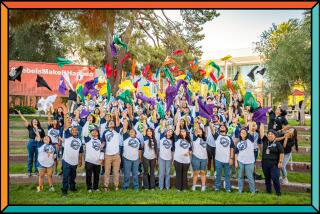Solving 2 Problems With One Program : Education: Potential dropouts and their young charges both reap benefits from Teen Outreach volunteer course.
- Share via
As a seventh-grader last fall at Horace Mann Middle School, Robert was one tough kid--a discipline problem uninterested in anything about school. But by the time the school year had ended, he was a changed person, a youth so compassionate with younger children that his teacher described him as “fatherly.”
What had changed? Robert had been enrolled in the Teen Outreach program, a nine-month classroom and community course in goal-setting and volunteer services for youths ages 12 to 18.
For several months of the spring semester, he volunteered to help first-graders at Jackson Elementary School learn to read. In return, he received the affection of kids who clamored for him, the first time in his life that Robert had really been the focus of any positive attention.
A project of the Junior League, Teen Outreach may be one of the best efforts at curbing the epidemic of school dropouts and failures, teen pregnancies and truancies among today’s students.
And it doesn’t cost a penny. In fact, the districts take in money from the state for each student who remains in school.
By assigning kids to volunteer positions of responsibility where they must help others, the program strives to build up their self-esteem and reinforces the notion that they have something worth contributing to society. That carries over into their school work.
For many students, this is the first time that they’ve had a positive experience connected with education--the first time they’ve had the opportunity to serve as role models.
Oftentimes, these are students who have had trouble learning to read, kids who suffer the stigma of perennially lagging behind classmates. These are the youngsters who never knew how to get attention in class, except by being disruptive and causing trouble.
But for the first time in their lives, they are patted on the back and actually thanked for their help.
From my own experience as a high school special education teacher, I know how much even a little encouragement can impact the lives of these students, how it can change their outlook on school and life in general.
We have nothing to lose by more widespread implementation of the Teen Outreach program in San Diego schools--and everything to gain.
The facts about high risk youngsters are sobering. It is estimated that in the San Diego Unified School District, some 20,000 students are “at risk” of dropping out. Students are dropping out at younger ages each year. Last year, the eighth-grade drop-out rate was 4.2%. The ninth-grade rate was 7.6%.
The statistics get worse as the students get older. Last year the drop-out rate for students in San Diego county high schools was 18.4%. For blacks it was 22.2% and for Latinos it was 28.1%. Sweetwater Union High School District had the highest rate at 27.1%. The state average was 20.4%.
As we all know, the repercussions of students dropping out before they are adequately educated or trained in a job skill are alarming. It is estimated that high school dropouts cost the U.S. Treasury some $240 billion in lost wages and taxes during their lifetimes.
Introduced in 1981 by the Junior League of St. Louis, the Teen Outreach program has now expanded to programs in middle schools and high schools in 38 U.S. communities.
Currently active in four area schools--San Diego High School, Mar Vista High, Wangenheim Junior High and Mann--the program consists of two components: classroom teaching and hands-on volunteering.
The in--school curriculum includes life planning, values, communication, how to deal with life pressures and family relationships. The course work and highly individualized attention attempts to address the fact that students who are at risk of dropping out of school are those who haven’t achieved much success.
It accepts them for who they are, with some of the limitations they have. It acknowledges that they may not come to class often, but are missed when they don’t attend. It offers them something they might enjoy doing when they do show up.
Little by little, small successes build on one another and their self-esteem grows.
Students volunteer about one hour a week. They receive school credit for anything from assisting senior citizens in convalescent homes, to reading to young students in libraries, to participating in food drives for the homeless.
Last year, for example, students at San Diego High School helped children in the pediatric unit at Balboa Naval Hospital with art projects and organized a Holiday Food Drive.
The program is in its infancy here, but a four-year evaluation of the project in 44 classroom sites in 14 U.S. cities showed its significant success at coping with difficult, sometimes intractable, educational problems.
According to the Junior League’s study, students involved in the program showed a 35.8% lower dropout rate, 42.4% fewer suspensions, and 8.5% fewer course failures between 1984 and 1988.
The alarming school drop-out rate affects us all--whether we have children in school or not. If the Teen Outreach results in progress that makes a difference in the lives of even a few students--if it motivates them to stay in school, to learn a skill, to become productive citizens--we all will benefit.






